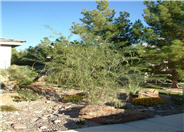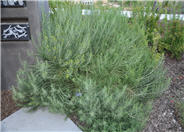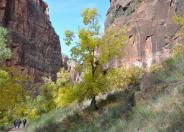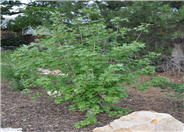
Common name:Desert Willow; Desert Catalpa
Botanical name:Chilopsis linearis
Desert Willow is a small, deciduous tree with shrubby inclinations. It grows about 15 to 25 feet tall and nearly as wide, with an open, though twiggy appearance. New bark is green, becoming brown and shaggy as it ages. Leaves are fine-textured, long and narrow, and willow-like. Remarkable, orchid-like flowers of white and pink appear in late spring and continue, to a lesser extent, all summer. It can be pruned as a multi-stemmed, low canopied tree or left more shrubby. There is a specimen at the Greater Avenues Water Conservation Demonstration Garden.

Common name:Rubber Rabbitbrush
Botanical name:Chrysothamnus nauseosus
Rubber rabittbrush is a Utah native, known for its chrome-yellow autumn flowers and strikingly white stems. This plant will reach a mature size of about 4 to 6 feet tall and wide. Fall flowers are chrome-yellow and cover the entire plant. Foliage is long, narrow, grey-green, and slightly hairy, giving it a whitish cast. It is semi-deciduous, and will hold its foliage well into the autumn and early winter. A great shrub for a hot, dry site.

Common name:Bigtooth Maple
Botanical name:Acer grandidentatum

Common name:Bigtooth Maple
Botanical name:Acer grandidentatum
This Utah native is an attractive tree well suited to our urban landscape. It grows 20 to 30 feet tall and about 20 to 25 feet wide. Large dark green leaves have 3 to 5 rounded lobes, and leaves turn yellow, orange, or red in autumn. Inconspictuous light green flowers in spring are followed by small reddish-tan sumara (those little helicopters). Bark is grayish with plate-like scales. Use as a large shrub or small tree; ideal as a patio tree or for screening.
| Designer: Stephanie Duer | Greater Avenues Demo 2 |
Photographer: GardenSoft |
Water Saving Tip:
Change spray sprinklers to low-flow bubbler or drip systems. Shrubs and trees are ideal candidates for this type of irrigation because the water is applied directly to the root zones.
